The biographical podcasts provided by The Walking Classroom introduce students to lots of famous folks. Besides scientists and historical figures, the podcasts share the lives of creators of all kinds — from amazing artists and inventors to other innovators. Be creative yourself! Think outside the box and develop a unit based on these folks.
All About Artists
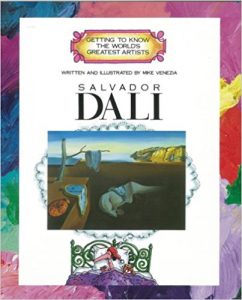 Introduce your class to the 20th century art movement known as surrealism. For some visual examples of the style, take a hop across the pond, and make a virtual field trip to Britain’s Tate. After your mini art lesson, check in on your students’ understanding with a quick online quiz. Then check out a podcast or two on surrealist artists!
Introduce your class to the 20th century art movement known as surrealism. For some visual examples of the style, take a hop across the pond, and make a virtual field trip to Britain’s Tate. After your mini art lesson, check in on your students’ understanding with a quick online quiz. Then check out a podcast or two on surrealist artists!
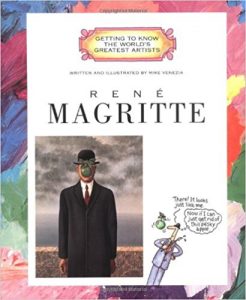 Meet Rene Magritte (5-#84, Complete-#31), a Belgian surrealist who frequently depicted ordinary objects in an unusual context, or learn about Salvador Dali (5-#85, Complete-#32), a Spanish surrealist best known for his painting of melting clocks, The Persistence of Memory.
Meet Rene Magritte (5-#84, Complete-#31), a Belgian surrealist who frequently depicted ordinary objects in an unusual context, or learn about Salvador Dali (5-#85, Complete-#32), a Spanish surrealist best known for his painting of melting clocks, The Persistence of Memory.
Seeking some kid-friendly books about these artists and other creators and innovators? Look no further than Mike Venezia’s “Getting to Know . . .” series (980L). Perfect for upper elementary students, these colorful, cartoon-style books captivate even the most reluctant readers. They detail the lives of artists, composers, inventors, and scientists, so they have got you covered! In fact, two books from Mike Venezia’s “Getting to Know the World’s Greatest Artists” series, Rene Magritte and Salvador Dali, will nicely supplement the podcasts!
Interesting Inventors
If you’re looking for a different type of creator, turn to the inventors. Take a journey through time, and listen to these podcasts chronologically.
Johannes Gutenberg (5-#23, Complete-#41) was a German who brought printing to Europe with the use of moveable type. Enhance your students’ understanding of Gutenberg, and introduce additional information with Johann Gutenberg and The Printing Press (GN 620L). Written by Kay Melchisedech Olson and illustrated by Tod G. Smith, the graphic novel format will definitely appeal to your upper elementary crew! You could easily extend the experience with a lesson plan developed by one of our adopters.
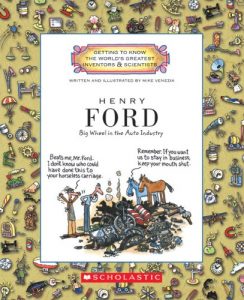 Founder of Ford Motor Company and developer of the assembly line, Henry Ford (4-#89, Complete-#112) helped get America moving by motor vehicle. Learn more about Henry Ford and other innovators past and present as you explore the Henry Ford Museum (virtually!), and check out the wealth of resources for educators that are available.
Founder of Ford Motor Company and developer of the assembly line, Henry Ford (4-#89, Complete-#112) helped get America moving by motor vehicle. Learn more about Henry Ford and other innovators past and present as you explore the Henry Ford Museum (virtually!), and check out the wealth of resources for educators that are available.
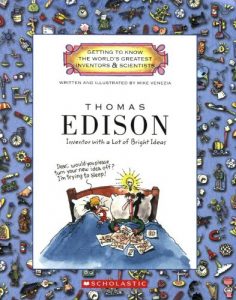 Identified as America’s greatest inventor, Thomas Edison (5-#16, STEM-#9, Complete-#162) was responsible for the development of many new technologies, such as the lightbulb, telegraph, motion picture camera, and phonograph! Read Don Brown’s picture book, A Wizard from the Start: The Incredible Boyhood and Amazing Inventions of Thomas Edison (940L), with your students, or share Thomas Edison – 10 Days (1050L) by David Colbert. The latter provides a glimpse into the top ten days in the inventor’s life.
Identified as America’s greatest inventor, Thomas Edison (5-#16, STEM-#9, Complete-#162) was responsible for the development of many new technologies, such as the lightbulb, telegraph, motion picture camera, and phonograph! Read Don Brown’s picture book, A Wizard from the Start: The Incredible Boyhood and Amazing Inventions of Thomas Edison (940L), with your students, or share Thomas Edison – 10 Days (1050L) by David Colbert. The latter provides a glimpse into the top ten days in the inventor’s life.
Sift through a Series
In his “Getting to Know the World’s Greatest Inventors & Scientists” series (980L), Mike Venezia shares the stories of a pair of these innovators. Introduce your students to Henry Ford in Henry Ford: Big Wheel in the Auto Industry. Meet Thomas Edison in Thomas Edison: Inventor with a Lot of Bright Ideas.
The “Childhood of Famous Americans” series also chronicles the lives of plenty of famous (American) figures, including inventors. Check out Henry Ford: Young Man with Ideas (650L) by Hazel B. Aird and Thomas Edison: Young Inventor (620L) by Sue Guthridge. Similarly, the “Who Was . . .?” series, offers possibilities for podcast pairings. Why not use one of these to add to the information your class derived from listening to the podcasts?
- Who Was Henry Ford? (960L) by Michael Burgan
- Who Was Thomas Edison? (790L) by Margaret Frith
. . . and in a Class by Himself!
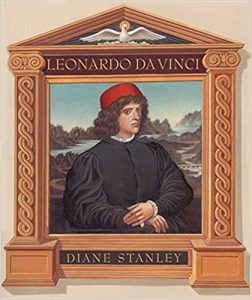 Crossing the boundaries, true “Renaissance man” Leonardo da Vinci (5-#26, STEM-#4) had achievements in both art and invention. If you are seeking to support your students’ study of da Vinci, there are a number of literary resources celebrating the innovative genius. Leonardo da Vinci (1010L) by Diane Stanley provides a visually stunning pictorial biography, a format absolutely apt for this artist, and it is sure to be enjoyed by your students.
Crossing the boundaries, true “Renaissance man” Leonardo da Vinci (5-#26, STEM-#4) had achievements in both art and invention. If you are seeking to support your students’ study of da Vinci, there are a number of literary resources celebrating the innovative genius. Leonardo da Vinci (1010L) by Diane Stanley provides a visually stunning pictorial biography, a format absolutely apt for this artist, and it is sure to be enjoyed by your students.
If you’d prefer to focus more on da Vinci’s inventions, you have a couple of options. Neo Leo: The Ageless Ideas of Leonardo da Vinci (930L) by Gene Barretta is one, and Leonardo da Vinci (920L) by Lorraine Jean Hopping is another. The latter is part of the “World of Inventors” series from Silver Dolphin Books, a series worth reviewing.
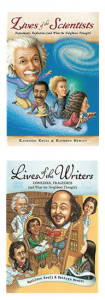 Check out a Collection of Creative Types!
Check out a Collection of Creative Types!
It may be helpful to have an anthology at hand if you want to learn about even more creators and inventors. A favorite of mine is the “Lives of . . .” series (1120L) by Kathleen Krull and Kathryn Hewitt. These 96-page books tell the tales (and share juicy details!) about groups of notable folks, with a chapter dedicated to each person. Nine in total, the books, each with a specific focus, cover the lives of a veritable array of innovators. Just take your pick, and learn more about musicians, athletes, artists, writers, explorers, scientists, presidents, pirates, and extraordinary women!
Be on the lookout for the next post in our Literary Links series, as we’ll focus on some other connections! You’ll discover more picture books, novels, and nonfiction works to partner with The Walking Classroom’s podcasts.


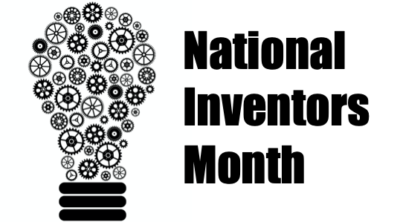
These podcasts have been a great asset to our learning in the classroom! The inventors tie into reading stories we use to study non-fiction elements. We have gained more knowledge about them when walking and listening and we have had rich discussions about each individual. The students also have the opportunity to have choice listening once a month, and many have listened to the artists podcasts as our wonderful visual art teacher has spoken about them in class!